Table 1.
Biopolymers used as nanoparticulate materials in agriculture and other fields: sources, structure, characteristics, and uses.
| Biopolymer | Source | Structure | Characteristics | References |
|---|---|---|---|---|
| Galactomannan | Extracted from the endosperm of leguminous seeds |
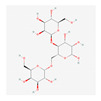 Composed of a linear chain of β-1, 4-D-mannopyranose to which α-1,6-D-galactopyranose units are attached. |
Used as films/coatings, gel agents, emulsion stabilizers, and thickeners. | [37,51] |
| Chitosan | The deacetylation of chitin (found in crustaceans and fungi) |
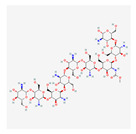 Deacetylated chitin, a linear polysaccharide of deacetylated beta-1, 4-D-glucosamine. Chemical name: (1,4)-2-Amino-2-deoxy- Beta-D-glucan. Functional groups: CH2OH, O, OH, NH2. |
Biocompatible, biodegradable, non-toxic, polyoxysalt formation, film-forming ability, adsorption properties; used in agriculture, food, pharma, and health sectors. | [41,52] |
| Tamarind seed polysaccharide | From the seed of the Indian date, tamarind (Tamarind indica L.) |
 The monomer of three main sugars,2 glucose, galactose, and xylose, in a molar ratio of 3:2:1. Made up of a (1 → 4) β-D-glucan backbone substituted with side chains of α-D-xylopyranose and β-D-galactopyranosy linked (1 → 2)-α-D-xylo-pyranose linked (1 → 6) to glucose residues. Functional groups: CH2OH, O, OH. |
High viscosity, adhesivity, non-carcinogenicity, broad pH tolerance, and biocompatibility. | [53,54] |
| Starch | Major carbohydrate form that is held in seeds, roots, rhizomes, and tubers |
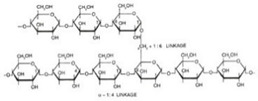 Chemical formula: (C6H10O5)n. Amylopectin (α-amylose) and amylose (β-amylose) constitute starch. Amylopectin (α-amylose) is branched, while β-amylose consists of linear chains. |
It is a tasteless, odorless powder insoluble in alcohol or cold water. Native starch’s significant swelling and quick enzymatic breakdown make it unsuitable for controlled-release medication delivery systems. |
[55,56] |
| Cellulose | A structural element of the major cell walls of oomycetes, several types of algae, and green plants |
 Cellulose (C6H10O5)n consists of a linear chain of several β(1 → 4) linked D-glucose units. Function group: OH, O. |
This non-toxic polymer, with high tensile and compressive strength, is utilized in the food, cosmetics, pharmaceutical, and nanotechnology industries. | [40] |
| Chitin | The primary sources of chitin are crustacean shells; also found in mycelia and the spores of many fungi |
 Poly β-(1 → 4)-N-acetyl-D-glucosamine, i.e., N-acetyl-d-glucosamine units with β-(1,4) bonds. Functional groups: CH2OH, O, OH. |
Biocompatible, bioreactive, and biodegradable; used in agriculture, food, environment, pharma, and health sectors. | [42,56] |
| Pectin | Present in plant cell walls within the middle lamella, occurring as calcium and magnesium salts |
 IUPAC:(2S,3R,4S,5R,6R)-3,4,5,6-tetrahydroxyoxane-2-carboxylic acid. |
It is used as a gelling agent but can also act as a thickener, water binder, and stabilizer and affects texture and viscosity in the food industry. | [38] |
| Agar | Obtained from Gelidium amansii (Gelidaceae) and other red algae |
 Agar consists of a mixture of agarose and agaropectin. It is composed of repeating alternate units of β-1,3-linked- D-galactose and α-1,4-linked 3,6 anhydro-L-galactose units. |
Insoluble in cold water, dissolves readily in boiling water, and melts above 85 °C. Agar is used as a suspending agent, emulsifying agent, and gelling agent in tissue cultures and microbiology studies. |
[43,57] |
| Alginate | Alginate is an anionic polymer and occurs naturally in the cell walls of brown algae (Phaeophyceae) |
 The alginates consist of 1,4-β-D-mannuronic acid (M) and 1,4 α-L-guluronic acid (G) monomers, with a homogeneous (poly-G, poly-M). |
Acts as an antimicrobial agent to reduce the reproduction of Rhizoctonia (fungi) disease in potatoes and enhances the uptake of some nutrient elements and fertilizers. | [44,58] |
| β-cyclodextrin | From different starch sources such as potato, corn, wheat, rice, and tapioca |
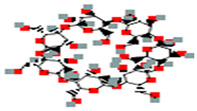 These are cyclic oligosaccharides commonly composed of six, seven, or eight D-glucose units (α-, β-, and γ-cyclodextrins, resp.) joined by α-(1,4) glycosidic bonds. |
Form molecular inclusion complexes with many compounds and thus have applications in the fields of medicine, food, pharmaceuticals, and cosmetics. | [59] |
| Dextran | Dextran is a complex branched glucan (polysaccharide derived from the condensation of glucose) |
 Branched poly-α-d-glucosides of microbial origin with glycosidic bonds predominantly C-1 → C-6. |
Used as plasma volume expanders and anticoagulants. They are also commonly used in biological experimentation. | [60,61] |
| Lignin | Lignin is the heterophenolic polymer found in the plant cell wall, particularly wood and bark |
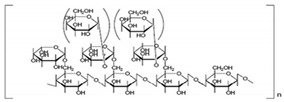 Lignin is composed of up to three different phenyl propane monomers, such as coniferyl alcohol, syringyl alcohol, and coumaryl alcohol units. |
Lignin + sulphated lignosulfonates are used as dispersants, binders, complexing agents, and emulsifying agents. Barrier against attack by insects and fungi. |
[38] |
| β-D-glucan | Found in a wide variety of cereal, plant, algae, bacteria, fungi, and yeast sources |
 Linear homopolysaccharides composed of D-glucopyranosyl residues (Glc p) linked via a mixture of β-(1 → 3) and β-(1 → 4) linkages. |
Its structural conformation and molecular weight make it useful in foods and biological entities. | [62] |
| Carboxymethylcellulose | Cellulose derivative formed by its reaction with alkali and chloroacetic acid |
 β-(1 → 4)-D-glucopyranose polymer chain of cellulose. |
Low toxicity, biodegradable, and excellent film-forming ability. Strong network structure and hydrophilicity. |
[63,64] |
| Polyhydroxybutyrate | Macromolecules synthesized by bacteria (Bacillus) under stress conditions |
 [4-Oxo-4-(4-oxobutan-2-yloxy)butan-2-yl] 3-hydroxybutanoate |
Biodegradability, use of renewable resources, better physical properties and non-toxic. | [65] |
| Carrageenan | Extracted from different species of red seaweeds |
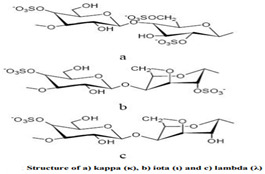 (β-(1,4)-D-galactose-α-(1,3)-D-galactose). |
Types: kappa (κ), iota (ι), and lambda (λ); these are used in the food industry as gelling agents and thickeners. The iota carrageenan contains two sulfated groups per repeating unit. | [57,66] |
| Gum acacia/gum arabic | Acacia senegal and Acacia seyal tree exudate |
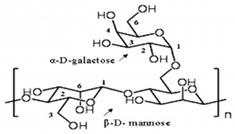 1,3-linked β-D-galactopyranosyl unit is present. L-arabinose, L-rhamnose, and D-glucuronic acid have also been identified as components of this polymer. |
Ca; Na; K; P; and traces of Pb, Co, Cu, Zn, Ni, Cd, Cr, and Mn are the most common minerals detected. High capacity for polymerization. | [36,67] |
| Guar gum | From seeds of guar gum (Cyamopsis Tetragonoloba) |
 1 → 4-linked β-D-mannopyranose backbone with branch points from their 6 positions linked to α-D-galactose (i.e., 1 → 6-linked α-D-galactopyranose), every galactose residue between 1.5–2 mannose residues. Functional groups: CH2OH, OH, O, H. |
Economical thickening and stabilizing agent; viscous pseudoplastic; high low-shear viscosity; shear thinning; less sensitive to ionic strength or pH; synergistic action with xanthan gum. | [43] |
| Cashew gum | Exudate of the cashew tree (Anacardium occidentale L.) |
 Cashew gum is built up of D-galactose, L-arabinose, D-galacturonic acid, and L-rhamnose (in traces). Functional groups: OH, O, COOH. |
Application as a gelling agent, in polyelectrolyte complexes, as a viscosity enhancer, in controlled delivery systems, as a surfactant, as a drying aid agent, as a coating agent, and in microencapsulation. | [47,68] |
| Xanthan gum | Obtained by fermentation of Gram-negative bacteria, Xanthomonas campestris |
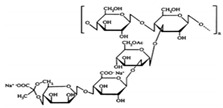 Five sugar residues: two glucose, two mannose, and one glucuronic acid. Functional groups: CH2OH, OH, O, COOH, H. |
High viscosity even at low concentrations. Compatibility with heat, pH, shear, enzymes, and chemicals as well as variations in ionic strength. |
[41,69] |
